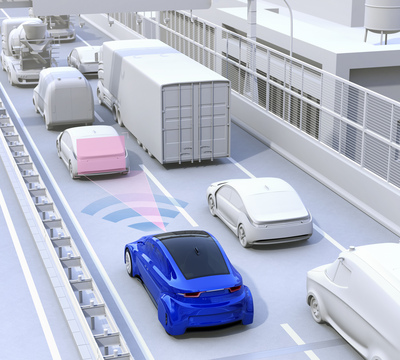LEGISLATIVE AND TECHNICAL AFFAIRS
Are ADAS Regulations on the Horizon?
What Aftermarket Companies Need to Know About Federal Safety Regulations
By Caroline Fletcher

As advanced driver-assistance systems (ADAS) become federally required on new vehicles, the burden on aftermarket parts manufacturers to ensure that their parts and a vehicle’s ADAS functions are compliant increases.
No one likes to be told what to do—especially by a government agency that doesn’t know anything about you or your business. It is, however, a legal requirement to follow the regulations set forth by these agencies. We all know how heavily regulated emissions-related aftermarket parts are, but other auto parts are regulated as well.
As advanced driver-assistance systems (ADAS) become federally required on new vehicles, the burden on aftermarket parts manufacturers to ensure that their parts and a vehicle’s ADAS functions are compliant increases. This article will help you make sure your company is up to speed with the current safety regulations and understands what might be coming down the pike.
There are two federal agencies that regulate automotive aftermarket parts: the U.S. Environmental Protection Agency (EPA), which oversees emissions-related parts, and the National Highway Traffic Safety Administration (NHTSA), which regulates parts for safety. This article focuses on safety regulations, although SEMA has a multitude of other resources for emissions-related information.
NHTSA has the authority to issue Federal Motor Vehicle Safety Standards (FMVSS) that set minimum performance standards for motor vehicles and motor vehicle equipment. The types of equipment that have their own standards is a relatively small selection of parts, including tires, headlamps/taillamps, and mirrors. It’s fairly easy to intuit that if you’re producing an aftermarket headlamp, for instance, it must comply with the standards set in FMVSS 108: Lamps, Reflective Devices, and Associated Equipment. Accordingly, it would be illegal to manufacture or sell lamps that, when installed, would make headlamps too bright or not bright enough based on the performance requirements of FMVSS 108.
The other type of FMVSS relates to vehicle-based standards—things such as front- and side-impact and roof-crush standards that apply to the vehicle as a whole and are intended to keep passengers safe in the event of a crash. Automakers must ensure that their vehicles comply with these standards.
However, just because you are an equipment manufacturer doesn’t mean you’re off the hook from these regulations. It is illegal to knowingly manufacture, sell or install any product—including aftermarket equipment—that would take a vehicle out of compliance with any safety standard, including the vehicle-based standards. This is informally known as the “make inoperative” provision.
How does NHTSA enforce this? Aftermarket companies selling parts (lift kits, for example) that don’t fall under a specific FMVSS must self-certify that, once installed, their part won’t take a vehicle out of compliance with any safety standards. Self-certification is automatically implied when offering the product for sale. Examples include testing, engineering analyses or computer simulations. While NHTSA won’t ask for this information unless it becomes aware of a safety issue, this data is important to ensure that your product is legal and your company is protected from potential liability.
Most people know that it’s hard for the government to accomplish anything, and NHTSA is no exception. New FMVSS are created through a long and sometimes slow process. In fact, technological advancements often become commonplace on new vehicles by the time NHTSA establishes a safety standard.
One reason for the delay is that NHTSA needs to establish a reputable test procedure that the agency will use for testing compliance. Meanwhile, the technology may continue to be refined and voluntarily installed on new vehicles while the test protocol is being developed.
NHTSA may use its five-star rating system, known as the New Car Assessment Program (NCAP), as a way to encourage installation of new technologies on new vehicles before a safety standard is established, which is currently the case with ADAS. The five-star rating program already includes four ADAS technologies: forward-collision warning, lane-departure warning, crash-imminent braking, and dynamic brake support. NHTSA is proposing to add four more ADAS technologies to NCAP: lane-keeping support, pedestrian automatic emergency braking, blind-spot warning, and blind-spot
intervention.
As noted, the implementation of a safety standard is what triggers the make-inoperative provision, and parts manufacturers must have a reasonable basis to conclude that their product won’t take a vehicle out of compliance with the standard.
Aftermarket companies need to consider how their products interact with vehicle technology even if there is no safety standard. In the case of ADAS, the customer will likely expect the technology to operate properly after an aftermarket part is installed. Further, there may be liability if a vehicle without functioning ADAS is involved in an accident. Looking back at the implementation of FMVSS 126, Electronic Stability Control (ESC), gives us insight into what to anticipate when ADAS safety standards are created.
In 2006, NHTSA proposed requiring installation of ESC systems on all new vehicles by 2011. The anti-rollover technology had already become popular with automakers in the years leading up to NHTSA’s proposal. The final rule became effective in 2008 and provided a three-year phase-in period for installation on new cars. SEMA and other industry groups were successful in securing an additional year (until 2012) for aftermarket companies to ensure that ESC systems continued to operate after a vehicle had been modified.

NHTSA is proposing to add four more ADAS technologies to NCAP: lane-keeping support, pedestrian automatic emergency braking, blind-spot warning, and blind-spot intervention.
SEMA launched a vehicle dynamics program in 2008 to provide member companies with access to on-track and computer simulation tests to demonstrate compliance with the ESC standard. SEMA’s new garage facility in Detroit is now developing a similar program to understand how aftermarket modifications affect ADAS. The information gleaned from this program is necessary to ensure that companies are prepared for what’s coming.
While there is currently a voluntary commitment by automakers to make automatic emergency braking (AEB) standard on most new vehicles by September, a federal standard is right around the corner. The U.S. Congress directed NHTSA to issue an AEB safety standard, and NHTSA is expected to issue a proposed rule later this year.
For more information on SEMA’s Detroit Garage, contact benjamink@sema.org. For more information on federal regulation of aftermarket parts, visit www.sema.org or contact carolinef@sema.org.






